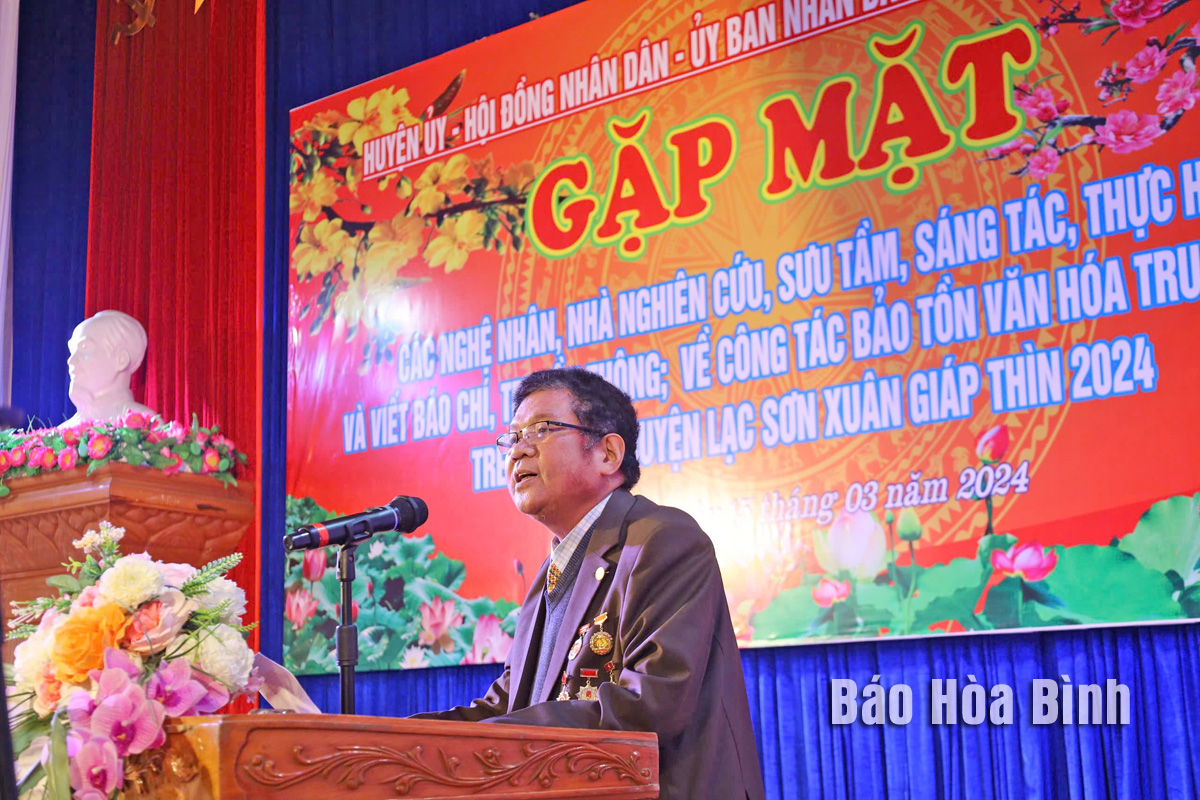
Having applied himself to researching and preserving traditional culture, Meritorious Artisan Bui Huy Vong in Huong Nhuong commune, Lac Son district, has won high regard from many people for his dedication to the Muong ethnic culture.
Meritorious Artisan Bui Huy Vong shares his journey to
research and preserve the Muong ethnic group’s culture.
Vong said researching and preserving the Muong
culture and bringing into play the good cultural values of ancestors in the
modern life is an arduous journey. However, thanks to support from district and
grassroots authorities as well as local artisans, he has obtained certain
achievements.
In particular, he has helped with the
restoration of some traditional festivals such as those of the Khenh Communal
House in Van Son commune, the Bang Communal House in Ngoc Son commune, and the
Khoi Communal House in An Nghia commune. He has written and published nearly 20
books, about 10 scientific articles on specialised magazines, along with
hundreds of articles, short stories, and research papers on central and local
media agencies.
Recalling difficulties and endeavours in the
restoration of local temples and festivals, Vong noted it took almost 10 years,
from 2001 to 2010, to rehabilitate the main hall of the Bang Communal House,
but it was not until 2016 that the Chay Dat - Chay Muong ritual of this site’s
festival was revived. Besides, it took up to 15 years, from 2003 to 2018, to
have the main hall and festival of the Khenh Communal House restored.
As the core zone of the Muong culture, Lac Son
district has also paid attention to revitalising the Muong ethnic singing. As a
result, the folk singing movement has become popular in the local community
over the last 10 years. Five clubs of "thuong rang” and "bo meng”, two types of
the Muong folk singing, have come into being, drawing more than 200 artisans.
Not only an artisan, collector, and researcher,
Vong is also one of the first person to post video clips about the Muong
singing on YouTube, attracting millions of viewers.
However, he is still concerned that many
valuable cultural heritages like the Vanh village stone shelter, the Trai
hamlet cave, Mo Muong, Muong gongs, as well as the customs and folk songs of
Muong people remain untapped. District authorities have just restored traditional
festivals and utilised the ethnic group’s space and cuisine for tourism
development.
Vong expressed his hope that the local Party
Committee and People's administration will hold regular meetings with artisans,
collectors, researchers, and those preserving the traditional culture. They
should create a space at major events and folk festivals for Muong singing
artisans in Lac Son, as well as those from across Hoa Binh province and other
localities, to engage in exchanges. In addition, it is important to pay more
heed to tourism promotion to bring into play the role of the local community
and artisans of the Muong culture.
Phong Phu commune, Tan Lac district of Hoa Binh province, is widely regarded as the cultural heartland of the Muong ethnic group. Among its many traditional communities, Luy Ai hamlet (formerly Ai hamlet) stands out as a rare location where the customs and way of life of the Muong Bi people remain largely intact.
The Truong Kha temple festival, a distinctive cultural event held every three years in Vu Ban township, Lac Son district, returned recently with vibrant rituals and folk traditions of the Muong people. Located next to the Buoi River in the Muong Trao fields, the Truong Kha Temple is dedicated to the three Kun Dol deities, revered for teaching farming techniques, irrigation, weaving, and protecting the harvest.
The demand for spaces serving community activities of residents in various areas across Hoa Binh city has been satisfied as local cultural houses now feature modern, spacious facilities thanks to the effective implementation of Resolution No. 49/NQ-HDND issued on December 28, 2021 by the city People's Council, which approved the plan for reorganising, converting, and allocating land for the construction, repair, and expansion of cultural houses in Hoa Binh’s villages and residential areas until 2025.
At the end of May, the Hoa Binh Provincial Ethnic Arts Troupe organized a series of performances for residents in Region 2 and Region 3 communes across the province. Bringing art to ethnic communities in remote, isolated, and especially disadvantaged areas has become a meaningful activity. These are not merely artistic performances but also journeys to disseminate cultural values, enrich spiritual life, and contribute to preserving the cultural identity of ethnic minorities.



